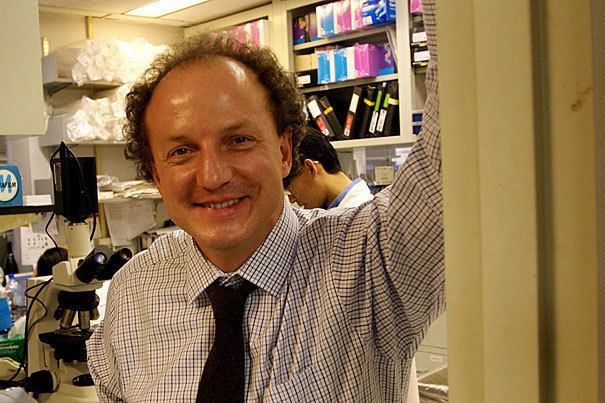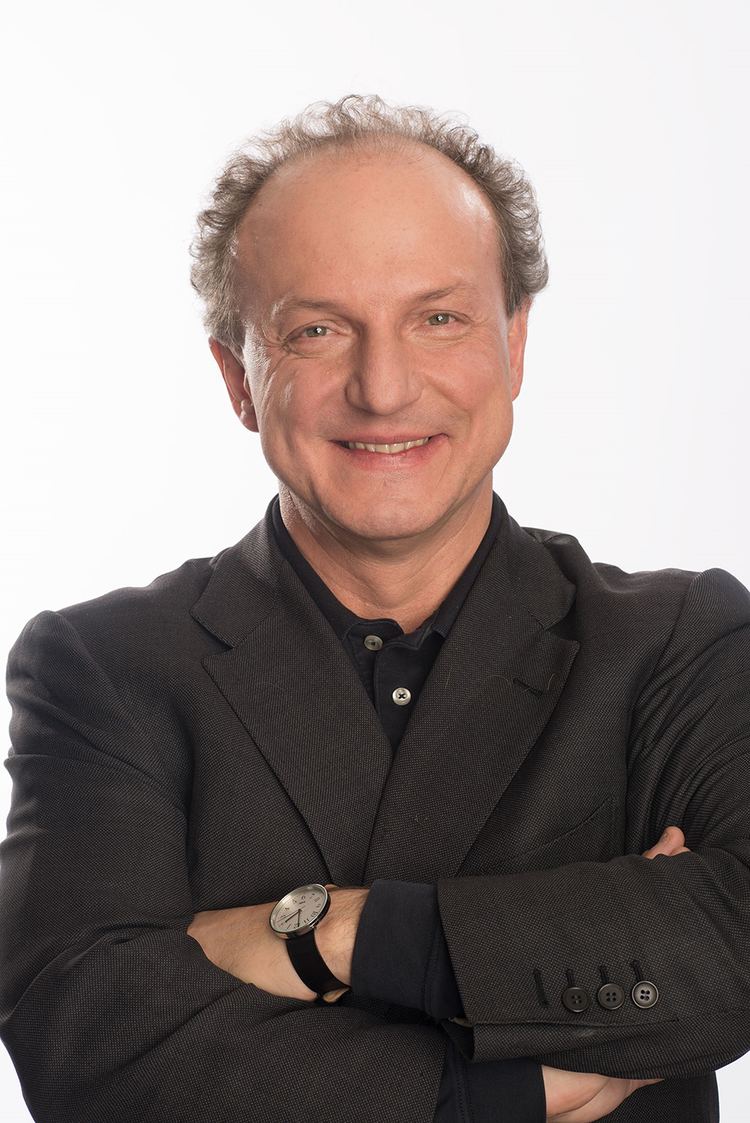Name Pier Pandolfi | ||
 | ||
Lewis cantley ph d and pier paolo pandolfi m d search for a cure
Pier Paolo Pandolfi, MD, PhD (born May 14, 1963) is an Italian-American geneticist and molecular biologist. His research focuses on the molecular mechanisms and genetics underlying the pathogenesis of leukemias and solid tumors. Pandolfi’s elucidation of fusion oncoproteins and genes involved in the chromosomal translocations of acute promyelocytic leukemia (APL) led to the development of effective therapies. APL is now considered curable. His research also yielded novel conceptual insights into the role of tumor suppressor genes in the development of human cancer with important therapeutic implications. Pandolfi’s extensive modeling of cancer in the mouse resulted in new discovery platforms that are used to evaluate drugs and predict the course of disease, treatment and resistance. Recently, he presented a theory describing how RNAs exert biological functions with profound implications for cancer biology and human health.
Contents
- Lewis cantley ph d and pier paolo pandolfi m d search for a cure
- AACR 2011 Pier Paolo Pandolfi MD PhD
- Biography
- Research
- Acute promyelocytic leukemia APL
- Cancer and developmental pathways
- Co clinical trials
- New paradigms in the function of tumor suppressor genes
- RNA research
- Awards and honors
- Selected recent publications
- References

Pandolfi is Director of the Cancer Center and the Cancer Research Institute at Beth Israel Deaconess Medical Center and George C. Reisman Professor of Medicine at Harvard Medical School. Previously, he was a faculty member at Memorial Sloan-Kettering Cancer Center and professor of at the Weill Graduate School of Medical Sciences at Cornell University. He is a recipient of the Weizmann Institute Lombroso Prize for Cancer Research and the Pezcoller-AACR International Award for cancer research. A citizen of both Italy and the United States, he was “knighted” by the Republic of Italy.

AACR 2011: Pier Paolo Pandolfi, M.D., Ph.D.
Biography

Pier Paolo Pandolfi was born May 14, 1963 in Rome, Italy. His parents were both humanities professors and both died of cancer. Pandolfi studied philosophy as an undergraduate at the University of Rome and went on to study medicine at the University of Perugia, where he received his MD in 1989. In 1995, he received a PhD in molecular and cellular biology from the same institution. He completed post-graduate training at the National Institute for Medical Research and the University of London in the United Kingdom. He married fellow scientist Letizia Longo, PhD, in 1991. They have two daughters.

Pandolfi continued his career in New York, where from 1994 to 2007, he received appointments in molecular biology and genetics. He served as Director of the Molecular and Developmental Biology Laboratory at Memorial-Sloan-Kettering Cancer Center and professor of biology, genetics and pathology at the Weill Graduate School of Medical Sciences at Cornell University.
In 2007, Pandolfi joined the faculty of Harvard Medical School and accepted an appointment as Scientific Director of the Cancer Center at Beth Israel Deaconess Medical Center. He currently holds the George C. Reisman Endowed Chair of Medicine at Harvard Medical School, where he is professor of medicine and pathology. In 2013, he was appointed Director of the Cancer Center and the Cancer Research Institute at BIDMC. He is an associate member of the Broad Institute of MIT and Harvard University. His laboratory is located at Beth Israel Deaconess Medical Center.
Research
Research carried out in Pandolfi’s laboratory has clarified the molecular mechanisms and genetics underlying the pathogenesis of leukemias, lymphomas and solid tumors, and modeled these cancers in the mouse. His basic and translational research has led to the development of many experimental trials. He has also presented a new theory describing how messenger RNAs and non-coding RNAs exert their biological functions with profound implications for human genetics, cell biology and cancer biology.
Acute promyelocytic leukemia (APL)
While a medical student, Pandolfi cloned and characterized PML-RARa (retinoic acid receptor alpha), the product of the long-sought after t(15;17) chromosomal translocation of acute promyelocytic leukemia (APL) and its normal counterpart promyelocytic leukemia protein (PML). Later, Pandolfi's lab deconstructed the genetics and complex molecular mechanisms underlying APL, studying other molecular subtypes that respond differentially to treatment. The lab identified optimal APL treatment strategies by modeling these APL subtypes in mice. As a result, combinatorial treatments are now available for each APL subtype, and APL is considered a curable disease. The lab further discovered that APL genes (e.g. PML, PLZF, NPM) are implicated in the pathogenesis of human cancer at large, beyond their involvement in APL, by acting as tumor suppressor genes (TSGs).
Cancer and developmental pathways
The role of developmental pathways and genes in tumorigenesis is a major focus of the lab. By analyzing APL genes and associated proteins, Pandolfi and colleagues tested the hypothesis that fundamental developmental processes are deregulated in cancer. Examples are PLZF and LRF/POKEMON, members of the POZ and Kruppel (POK) family of transcriptional repressors. PLZF is the second most frequent RARa partner in APL associated chromosomal translocations. More recently the lab identified POKEMON (for POK, Erythroid, Myeloid ONtogenic factor), also a member of the POK family, as a key player in tumorigenesis. Pandolfi showed that both proteins play critical and essential roles in both developmental processes and cancer pathogenesis. Other example are Pandolfi’s identification of NPM1 and PTEN as essential developmental genes.
Co-clinical trials
Based on his experience modeling APL in the mouse, Pandolfi developed the “Co-Clinical Trial Project,” a paradigm for conducting clinical trials concurrently in humans and in mice. This platform utilizes a variety of mouse models, with a focus on genetically engineered mouse models, generated to mimic the spontaneous incidence observed for human cancer. By mirroring human clinical studies in these genetically engineered mouse models (i.e. a Co-Clinical approach) scientists can stratify patients and identify optimal therapies based on molecular determinants. Pandolfi and colleagues have proposed a “Mouse Hospital” model to standardize infrastructure and practices for these co-clinical trials.
New paradigms in the function of tumor suppressor genes
The Pandolfi Lab extensively characterized the function of major tumor suppressors including PML, p53, INPP4B and PTEN, in vivo in the mouse. This in turn led to the new conceptual advances with important implications for cancer prevention and therapy. For example, the demonstration that even a subtle downregulation in the dose of PTEN can lead to tumorigensis lead to the notion of tumor suppressor qausi-insufficiency, and prompted therapeuticc efforts towards PTEN activation. Conversely, the Pandolfi Lab discovered that complete abrogation of tumor suppressor genes can elicit failsafe mechanisms such as cellular senescence and cancer stem cell exhaustion that can be hijacked for therapy.
RNA research
In recent years, non-coding RNAs have emerged as a new area of investigation within the mammalian transcriptome. Micro RNAs, long non-coding RNAs, pseudogenes and circular RNAs vastly outnumber the protein coding mRNA dimension. The Pandolfi Lab recently contributed to determine the importance of this non-coding RNAs dimension in tumorigenesis, through in vivo modeling efforts in the mouse. Pandolfi has also presented a theory describing how non-coding RNAs as well as protein coding messenger RNAs can cross-talk through a new RNA language by acting as “competing endogenous RNAs” (ceRNAs). This in turn attributes a “non-coding” function to mRNAs, and makes it possible to bioinformatically predict and experimentally validate how RNA communicate in both physiology and disease.
Awards and honors
Pandolfi has received more than 30 awards for his research, including consecutive NCI Merit Awards and, more recently, the NCI Outstanding Investigator Award. A few selected recognitions are as follows:
Selected recent publications
Recent publications from a total of 456:
